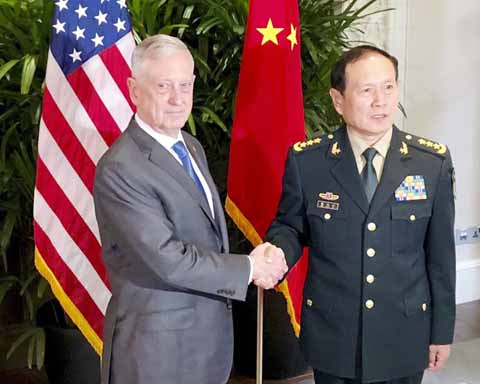
Reuters, Singapore :
US Defense Secretary Jim Mattis held high-profile talks with his Chinese counterpart on Thursday, as the United States seeks to forge to more resilient military ties that can withstand mounting pressure between the world’s two largest economies.
Mattis saw first hand last month how growing Sino-U.S. friction can undermine military contacts when Beijing up-ended plans for him to travel to China in October to meet Defense Minister Wei Fenghe. It was apparent retaliation over U.S. sanctions.
Mattis and Wei made no remarks as the two shook hands at the start of their talks in Singapore, which took place on the sidelines of a gathering of Asian defense ministers.
Randall Schriver, a U.S. assistant secretary of defense who helps guide Pentagon policy in Asia, said making military-to-military ties with China less brittle would be crucial to helping reduce the chances of a devastating conflict.
“Two nuclear-armed powers with regional, if not global, interests – we need to make sure that when we step on one another’s toes, it doesn’t escalate into something that would be catastrophic,” Schriver told reporters traveling with Mattis.
Schriver said he believed that sentiment was shared by China’s military, noting that it recently requested Thursday’s talks in Singapore after Beijing decided against a planned Mattis-Wei meeting in China.
“I think the fact that he’s meeting with Minister Wei is some evidence that the Chinese are interested in keeping things normal and stable, as are we,” said Schriver, assistant secretary of defense for Asian and Pacific security affairs.
He said Wei had a standing invitation to visit the United States.
Military-to-military ties have long been one of the more fragile parts of the overall U.S.-China relationship, with Beijing limiting contacts when tensions run high. That has been a source of major concern for years among U.S. officials, who fear an accidental collision or mishap could quickly escalate.
“What we want in terms of stability are regular interactions at senior levels so we have a good understanding of one another’s intentions, that we have confidence-building measures that will help us prevent an unintended accident or incident,” Schriver said.
“And, should one occur, that we have the ability to manage that so it doesn’t worsen.”
China has been infuriated by the United States putting sanctions on China’s military for buying weapons from Russia, and by what Beijing sees as stepped-up U.S. support for self-ruled Taiwan, claimed by China as its sacred territory.
In a recent reminder of the risks amid rising tensions, the Pentagon this month accused China of an unsafe and unprofessional maneuver in the South China Sea that brought a Chinese ship dangerously close to a U.S. Navy destroyer in international waters.
Mattis, speaking to reporters as he flew to Asia this week, rejected Chinese claims that the United States was acting aggressively and pointed the finger at Beijing.
“When the Chinese ships are putting bumpers over the side … You don’t do that when you’re out in the middle of the ocean, unless you’re intending to run into something,” Mattis said.
But tensions between the United States and China have already extended well beyond naval maneuvers and even the bitter trade war.
U.S. President Donald Trump last month accused China of seeking to meddle in Nov. 6 congressional elections, a charge almost immediately rejected by Beijing.

